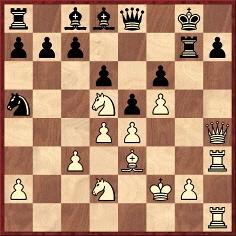
Edward Winter
A straightforward quiz question: in the game below (E. Kemeny v H.N. Pillsbury, Philadelphia, 30 October 1895) at which move was a mate missed?
1 e4 e5 2 Nf3 Nc6 3 Bc4 Bc5 4 b4 Bxb4 5 c3 Bd6 6 d4 Nf6 7 O-O O-O 8 Nbd2 Qe7 9 Bd3 Ne8 10 Nc4 f6 11 Ne3 g6 12 Nd5 Qd8 13 Be3 Be7 14 Nd2 d6 15 f4 Ng7 16 f5 g5 17 h4 gxh4 18 Qg4 Kh8 19 Qxh4 Qd7 20 Kf2 Bd8 21 Rh1 Ne8 22 Rh3 Na5 23 Rah1 Rf7 24 Be2 Rg7 25 Bh5 Kg8 26 Bxe8 Qxe8

27 Qxh7+ Rxh7 28 Rxh7 Bxf5 29 exf5 Qf8 30 Rh8+ Kf7 31 R1h7+ Qg7 32 Bh6 Qxh7 33 Rxh7+ Kg8 34 Rg7+ Kh8 35 Ne4 Resigns. [See pages 262-263 of Kings, Commoners and Knaves.]
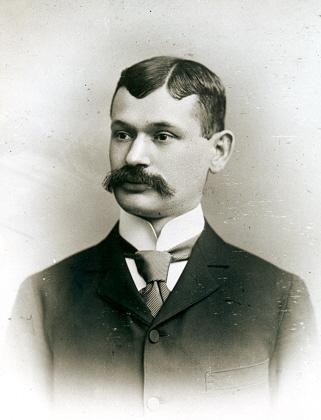
Emil Kemeny
The present article catalogues some of the relatively little-known examples of missed mates. Another nineteenth-century illustration is J.H. Zukertort v Adair, Chicago, 10 January 1884:
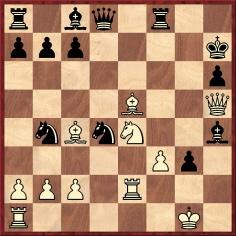
Black has just captured a pawn with 23…Nf5xd4, and White replied 24 Rd2. (The game ended 24…Nxf3+ 25 Qxf3 Rxf3 26 Rxd8 Bxd8 27 White resigns.) A reader of the New Orleans Times-Democrat showed that there was a forced mate in three with 24 Bg8+.
Source: La Stratégie, 15 March 1884, pages 78-79.
A couple of years later this position arose (J.M. Hanham v J.S. Ryan, New York, 1886):
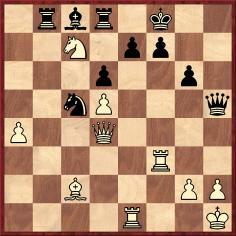
White played 31 Rxe7 and won easily, but a mate in three was available through a double rook sacrifice: 31 Rxf7+ Kxf7 32 Rxe7+ Kxe7 33 Qg7 mate. This was given by Philip Richardson on page 254 of the International Chess Magazine, August 1886.
From G. Mackenzie v M. Judd, 12th match-game, New York, 1881:
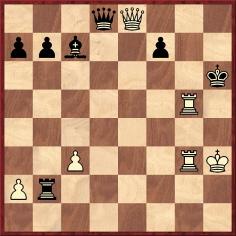
The game ended 40 Rg6+ Kh5 41 R3g5+ Qxg5 42 Rxg5+ Kxg5 43 Qe7+ Kg6 44 Qxc7 Resigns. Steinitz reported in The Field Mackenzie’s observation after the game that he could have played 41 Qh8+, with mate next move. A reader of La Stratégie, Bavoux, also pointed out the possible conclusion 40 Rh5+ Kxh5 41 Qxf7+ Kh6 42 Qg6 mate. Source: La Stratégie, 15 July 1881, pages 204-206, and 15 September 1881, page 282.
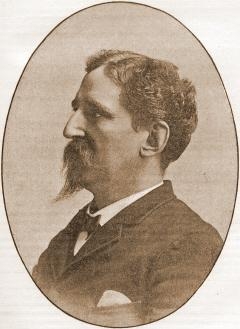
George Henry Mackenzie
The following position arose in R.J. Guckemus v F.J. Marshall, Sylvan Beach, August 1904:
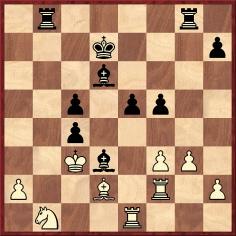
Source: American Chess Bulletin, September 1904, page 75. (If the score of this tournament game in various databases were to be believed, Black’s f-pawn would be at f6.) Marshall won by 27…Bxb1 28 Bc1 Bd3 29 Bb2 Bc7, after which White resigned, but there was a quiet mate in two beginning with 27…Bc7. A curiosity is that after 28 Rxe5 Black’s bishop can mate at either a5 or e5.
A strange game occurred between P.S. Leonhardt and E. Znosko-Borovsky in Ostend on 27 June 1906:
1 f4 d5 2 e3 c5 3 Bb5+ Nc6 4 Nf3 Bd7 5 b3 e6 6 Bb2 Nf6 7 O-O Bd6 8 Nc3 a6 9 Bxc6 Bxc6 10 Ne2 Qe7 11 Ne5 Bxe5 12 fxe5 Ng4 13 h3 Nh6 14 Qe1 O-O 15 g4 Qg5 16 Kh2 Rad8 17 Rf4 d4 18 exd4 cxd4 19 Ba3 d3 20 cxd3 Qxe5 21 Bxf8 Kxf8 22 Kg1 Rxd3
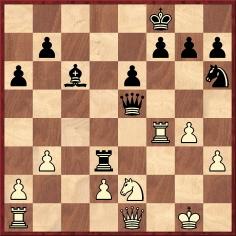
Now White, in time pressure, put his queen en prise, but Black overlooked 23…Qxe1+ (with mate next move).
23 Nc1 Qxf4 24 Nxd3 Qf3 25 Nf4 Qxf4 26 White resigns.
Source: La Stratégie, 20 September 1906, page 276.
Next, a curiosity from the game I. Spero v J.W. Showalter, Louisville, 1922:
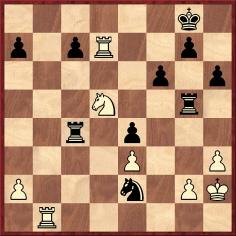
In this position a draw was agreed. White thus overlooked mate in two with 34 Nxf6+, a possibility which both players saw two minutes after the game was over. Source: American Chess Bulletin, December 1922, page 191.
Then there is a double example, which we took from pages 215-216 of the Australasian Chess Review of 20 August 1933 (W. Winter v J.E.W. Gemzøe, Folkestone Olympiad, 21 June 1933):
1 c4 e5 2 Nf3 Nc6 3 Nc3 Nf6 4 d4 exd4 5 Nxd4 Bb4 6 Bg5 h6 7 Bh4 O-O 8 Rc1 Ne5 9 e3 Ng6 10 Bg3 Ne4 11 Bd3 Bxc3+ 12 bxc3 Nxg3 13 hxg3 Ne5 14 Bb1 d6 15 Qc2 f5 16 Rh5 Qe8 17 Qe2 Ng4 18 Rh4 g5 19 Bxf5 Nxf2 20 Rxh6 Bxf5 21 Qxf2 Bd3 22 Nf3 g4 23 Rd1 Be4 24 Rd4 gxf3 25 gxf3 Rxf3 25 Qh2 Kg7 26 Qh2 Kg7 27 Qh4 Bf5
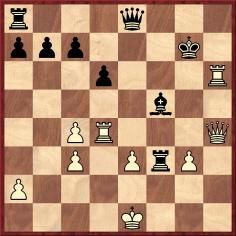
28 Rg4+ Bxg4 29 Qg5+ Kf7 30 Rh7+ Ke6 31 Qxg4+ Ke5 32 Qg5+ Ke4
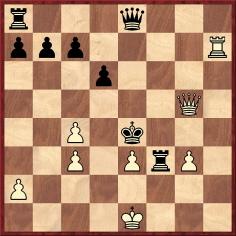
33 Qh4+ Kd3 34 Qd4+ Kc2 35 Rh2+ Kb1 36 Qd1 mate.
As mentioned in C.N.s 213 and 259 (see page 262 of Kings, Commoners and Knaves), a couple of mates in two were found shortly afterwards: 28 Qf6+ Kg8 29 Rh8 and 33 Qd5+ Kxe3 34 Qd4.
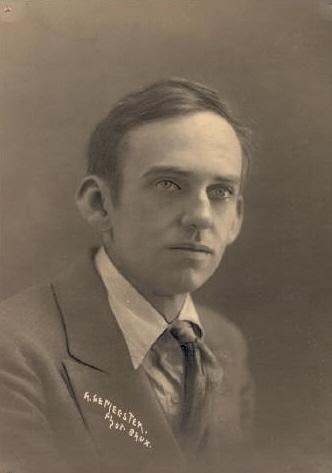
The above photograph (from C.N. 4356) of William Winter was sent to us by Luc Winants (Boirs, Belgium), from the collection of Daniël De Mol.
Even specimens of a mate in one being overlooked are less scarce than might be thought. In C.N. 414 W.H. Cozens pointed out a number of master games (the italics indicate the overlooker):
Readers may care to find these scores, and the missed mates, for themselves, but the nineteenth-century game is given here:
1 e4 c5 2 Nf3 e6 3 Nc3 Nc6 4 d4 cxd4 5 Nxd4 Nf6 6 Nxc6 bxc6 7 Bd3 d5 8 exd5 cxd5 9 Bg5 Be7 10 O-O O-O 11 a3 Bb7 12 Kh1 e5 13 f3 h6 14 Bh4 Nh5 15 Bf2 Nf4 16 Bg3 Bg5 17 Re1 Re8 18 Ne2 Qf6 19 Bxf4 Bxf4 20 Bb5 Red8 21 c3 e4 22 Nd4 Qh4 23 g3 Bxg3 24 Re2 exf3 25 Nxf3 d4 26 Rg2 Qh5 27 Nxd4 (‘The tournament book has a note at this very move, but also fails to see the pinmate’, remarked Cozens in C.N. 414.)
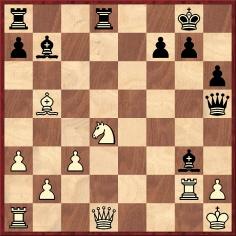
27…Bxg2+ 28 Kxg2 Qxh2+ 29 Kf3 Qf2+ 30 Ke4 Qf4+ 31 Kd3 Qf5+ 32 Kc4 Qd5+ 33 White resigns.
Source: tournament book, pages 311-312.
So far we have found only one published game, a minor skirmish between George H. Selkirk and J.C.R (in which White gave the odds of his queen’s rook), where a mate in one was overlooked on consecutive moves:
1 e4 e5 2 Nf3 Nc6 3 Bc4 Bc5 4 O-O Nf6 5 d4 exd4 6 e5 d5 7 exf6 dxc4 8 Re1+ Be6 9 Ng5 Qd5 10 Nc3 Qf5 11 g4 Qxf6 12 Nd5 Qd8 13 Rxe6+ fxe6 14 Nxe6 Qd7 15 Qe2 Be7 16 Ndxc7+ Kf7 17 Qxc4 Ne5 18 Qb3 Kf6 19 g5+ Kg6 20 f4 Nc6 21 f5+ Kxf5 22 Qd3+ Kg4 23 Qe4+ Kh5
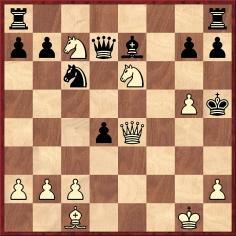
24 h4 h6 25 Qf3+ Kg6 26 h5+ Kh7 27 g6+ Kg8 28 Qf7 mate.
Source: Land and Water, 1 November 1873. Selkirk was the author of The Book of Chess (London, 1868) and, the previous year, Guide to the Cricket-Ground.
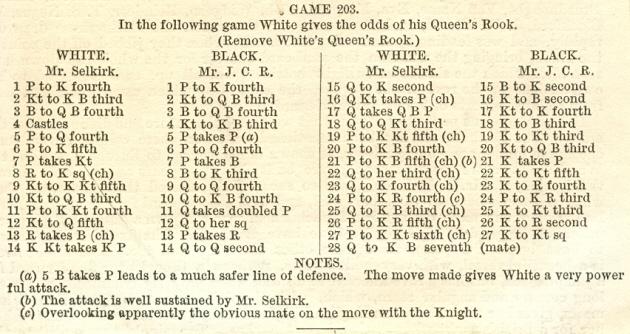
The position below (White to move) is from the game A. Steiner v L. Prins, Munich Olympiad, 1936)
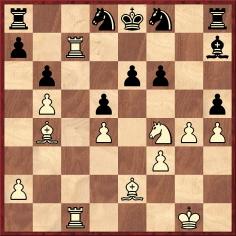
White played 32 Nxh5 Nf7 33 Ng7+ Resigns.

Above is the game on page 81 of Olympische Blitzsiege by E.J. Diemer (an undated book published in Kecskemét). The missed mate was pointed out in C.N. 1301. (See page 15 of Chess Explorations.)
From another tournament game (C. Schlechter v J. Mieses, Leipzig, 13 September 1894):
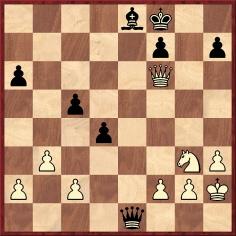
Black played 30…Qe7, and Schlechter continued with 31 Qh6+. Despite missing the mate in one, he went on to win the game at move 52.
In C.N. 5669 Alan O’Brien (Mitcham, England) noted that on page 2 of Anatoly Karpov His road to the World Championship by M. Botvinnik (Oxford, 1978) a mate in one was missed in the notes to the first match-game between Polugayevsky and Karpov, Moscow, 1974:
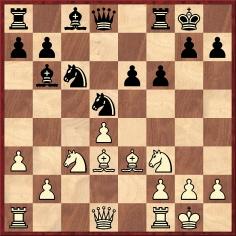

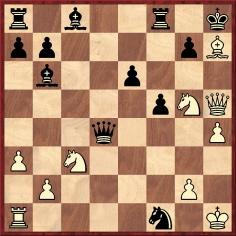
Position after 22 Kh1 (analysis by Botvinnik)
Rather than 22...Ng3+ Black has 22...Qg1 mate. The error was on page 17 of the Russian edition, Tri Matcha Anatolia Karpova (Moscow, 1975).
Frederick S. Rhine (Park Ridge, IL, USA) added in C.N. 6140 another missed mate in one, from the account on page 51 of ‘Mr Chess’ The Ortvin Sarapu Story by Ortvin Sarapu (Wainuiomata, 1993):

Matanović eventually agreed to a draw after Black’s 54th move.
Below, from C.N. 2660 (see page 292 of A Chess Omnibus), is a nomination for the worst move ever played. In the game J. Loffroy v E. Anglarès, Marseilles, September 1928 White blundered away his queen rather than using it to give mate in one:
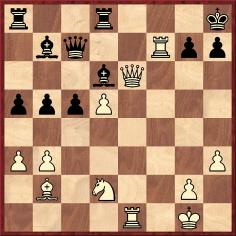
Black tried the desperate 24…Bxd5, and the game continued 25 Bxg7+ Kg8 26 Rf8+ Kxg7.
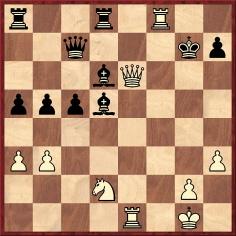
Instead of 27 Qf6 mate White now played 27 Qg8+.
Source: Les Cahiers de l’Echiquier Français, issue 20, page 128.
In conclusion we return to the quiz question. In the Kemeny v Pillsbury game, White missed a mate in one at move 33. See pages 262-263 of Kings, Commoners and Knaves. Our source for the game is page 267 of Harry Nelson Pillsbury American Chess Champion by Jacques N. Pope (Ann Arbor, 1996), which took the score from the New York Daily Tribune of 31 October 1895 but did not point out the missed mate.
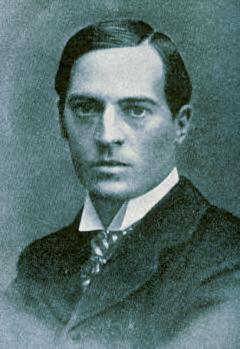
Harry Nelson Pillsbury
In C.N. 6280 Frederick S. Rhine drew attention to page 96 of On Top of the Chess World by L. Christiansen, J. Fedorowicz and I. Gurevich (San Francisco, 1995), where Gurevich annotated the 14th match-game between Kasparov and Anand:
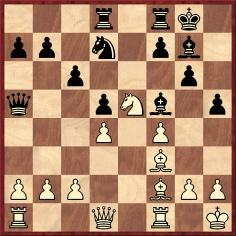
Anand’s 17...Qc7 received this comment by Gurevich:
‘Black could not do without this move, since 17...f6 18 Nd3 Nb6? is bad due to 19 Be1! Qb5 19 [sic] Nc5.’
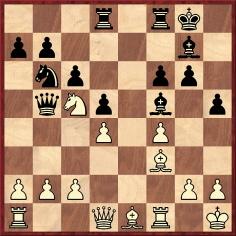
Mr Rhine commented: ‘20...Qxf1 mate would be a strong rejoinder.’
Another item, C.N. 6276, remarked that there cannot be many books by a master in which a move awarded an exclamation mark allows mate in one. From page 95 of The Fireside Book of Chess by I. Chernev and F. Reinfeld (New York, 1949):
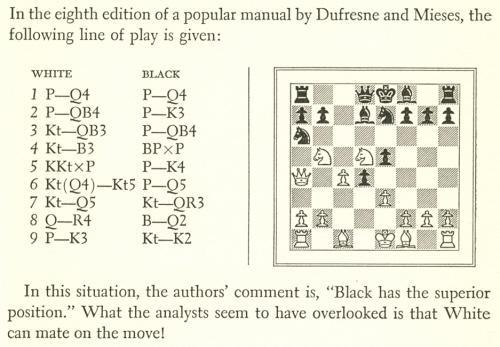
Concerning the references to ‘the authors’ comment’ and ‘the analysts’, it should be noted that the eighth edition of the book in question, Kleines Lehrbuch des Schachspiels, was published in 1910, i.e. some 17 years after Dufresne’s death. The title page stated ‘Kleines Lehrbuch des Schachspiels. Von Jean Dufresne. Achte verbesserte Auflage. Herausgegeben von Jacques Mieses’.
Below is the relevant section of page 398, in a note to 8 e3:
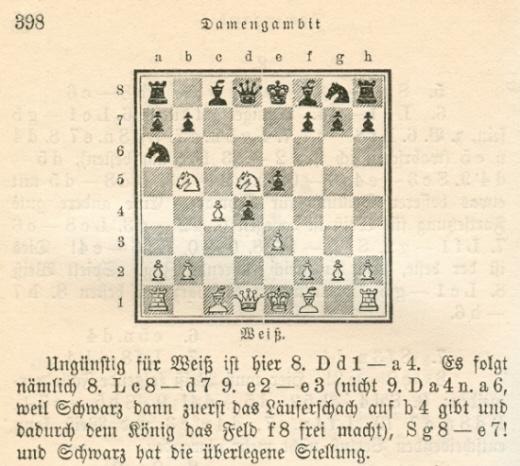
In C.N. 6288 Andreas Saremba (Brieselang, Germany) noted that the seventh edition of the book (1901) had only six pages of variations on the Queen’s Gambit (as opposed to 13 pages in the eighth edition) and did not even mention the Tarrasch Defence (3...c5). Moreover, the error in the eighth edition was corrected on page 397 of the ninth edition, published in 1916, through the interposition of ...Bb4+ before ...Ne7:

As mentioned in C.N. 6276, the following different amendment appeared on page 397 of the tenth edition, published in 1923:


Jacques Mieses
In C.N. 2117 Richard Forster (Zurich) referred to the position which arose after White’s 25th move in Réti v Marshall, New York, 1924 (see pages 165-166 of the English-language tournament book, published in 1925):

Play went 25...Nxg3 26 Rhg1, and Alekhine wrote: ‘Or 26 hxg3 Qxg3+ 27 Ke2 Qg2+ 28 Kd3 Rxh1 29 Rxh1 Qxf3+, to be followed by 30...Qxh1, with an easy win.’ Instead, there is 28...Qc2 mate.
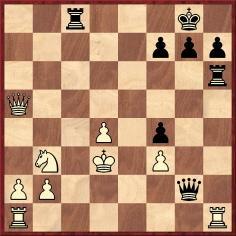
Analysis by Alekhine (position after 28 Kd3)
On page 33 of his 1929 book Schachmethodik Tartakower also ignored the mate, as did Soltis on page 270 of Frank Marshall, United States Chess Champion (Jefferson, 1994).
C.N. 2131 remarked that in the original 1925 edition of Alekhine’s tournament book W.H. Watts gave a nine-page errata supplement which mentioned (on page vi) 28...Qc2 mate, and when discussing the matter further on pages 283-284 of Kings, Commoners and Knaves we drew attention to some complications. Here is the complete game-score as it appeared in the tournament book (English and German editions):
Richard Réti – Frank James Marshall
New York, 6 April 1924
Queen’s Gambit Declined
1 Nf3 Nf6 2 c4 d5 3 cxd5 Nxd5 4 d4 Bf5 5 Nc3 e6 6 Qb3 Nc6 7 e4 Nxc3 8 exf5 Nd5 9 Bb5 Bb4+ 10 Bd2 Bxd2+ 11 Nxd2 exf5 12 Bxc6+ bxc6 13 O-O O-O 14 Qa4 Rb8 15 Nb3 Rb6 16 Qxa7 Qg5 17 Qa5 c5
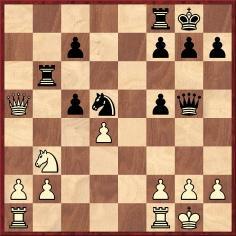
18 Qxc5 Nf4 19 g3 Rh6 20 Qxc7 Ne2+ 21 Kg2 Qg4 22 Rh1 f4 23 f3 Qh3+ 24 Kf2 Rc8 25 Qa5 Nxg3 26 Rhg1 Qxh2+ 27 Rg2 Qh4 28 Rc1 Re8 29 Qb5 Ne4+ 30 Kf1 Qh1+ 31 White resigns.
However, we observed, when Réti annotated the game on pages 259-260 of the September 1924 Wiener Schachzeitung he gave White’s 18th move as 18 dxc5. If that were correct, Alekhine would have missed no mate later in the game. Hanon Russell (Milford, CT, USA), who possessed the original score-sheets of both Réti and Marshall, informed us that they respectively gave White’s 18th move as ‘Dxc5’ and ‘QxP’. A later transcription error in the German notation would have been easily made (i.e. ‘Dxc5’ becoming ‘dxc5’).
On page 126 of Das New Yorker Schachturnier 1927 (Berlin, 1928) Alekhine wrote regarding the communication of game-scores by telegraph:
‘But in general more accurate wire information for the foreign press should be provided during American tournaments. In 1924, for example, a similar error resulted in a wholly incorrect judgment of Marshall’s win against Réti.’
Here, a further point in this complex affair may be added. In 1924 Alekhine also annotated the game in Le Pion (Montreal); see pages 116-117 of the May 1924 issue of La Stratégie. He gave White’s 18th move as Qxc5, and at move 26 merely wrote, ‘If 26 hxg3 Qxg3+ 27 Ke2 Qg2+, winning easily’.
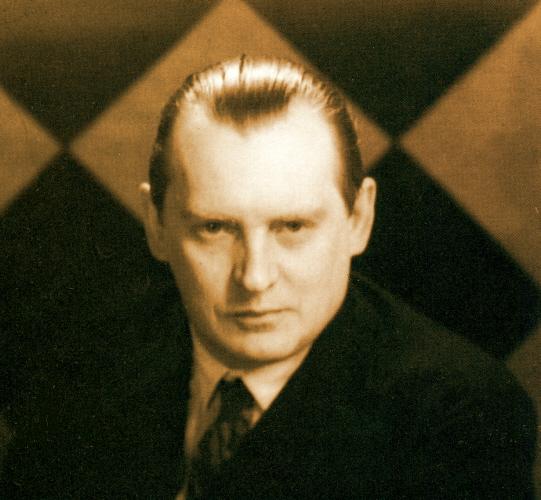
Alexander Alekhine
Our final example was pointed out by Frederick S. Rhine in C.N. 6281. It comes from page 197 of Complete Defense to King Pawn Openings by Eric Schiller (New York, 1998), in the game Ghinda v W. Watson, Thessaloniki, 1988:

The position after 22 Rxe6:
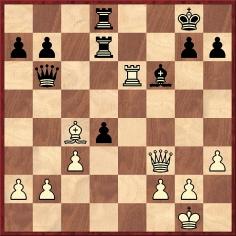
Schiller observes that Watson’s suggestion 22...Qc5 allows 23 Re8 mate. So, instead, Schiller recommends 22...Qc7, overlooking that it allows 23 Re8 mate.
The above two articles originally appeared at ChessBase.com.
Regarding the above-mentioned Steiner v Prins game (C.N. 1301), in a letter to us dated 22 October 1987 Lodewijk Prins wrote:
‘I cannot explain Steiner’s overlooking a mate in one. If the diagrammed position is correct, both sides must have been extremely short of time, I should think.’
The complete score of one of the above games was given in C.N. 2807:
B.W. Fisher – Curt von Bardeleben
Vizayanagaram tournament, London, 1883
Sicilian Defence
1 e4 c5 2 Nf3 e6 3 Nc3 Nc6 4 d4 cxd4 5 Nxd4 Nf6 6 Nxc6 bxc6 7 Bd3 d5 8 exd5 cxd5 9 Bg5 Be7 10 O-O O-O 11 a3 Bb7 12 Kh1 e5 13 f3 h6 14 Bh4 Nh5 15 Bf2 Nf4 16 Bg3 Bg5 17 Re1 Re8 18 Ne2 Qf6 19 Bxf4 Bxf4 20 Bb5 Red8 21 c3 e4 22 Nd4 Qh4 23 g3 Bxg3 24 Re2 exf3 25 Nxf3 d4 26 Rg2 Qh5 27 Nxd4 (‘The tournament book has a note at this very move, but also fails to see the pinmate’, remarked W.H. Cozens in C.N. 414.)
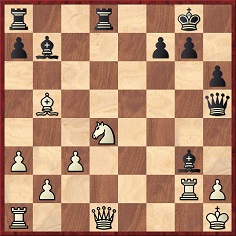
27...Bxg2+ 28 Kxg2 Qxh2+ 29 Kf3 Qf2+ 30 Ke4 Qf4+ 31 Kd3 Qf5+ 32 Kc4 Qd5+ 33 White resigns.
Source: tournament book, pages 311-312.
One of Capablanca’s most impressive simultaneous games was against J.H. White (of Modern Chess Openings fame) in London on 6 August 1919 (see pages 154-155 of The Unknown Capablanca. Unfortunately, however, there is an imperfection: Capa’s 51st – which, admittedly, provoked White’s (i.e. Black’s...) resignation – was not the best.
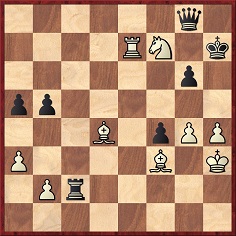
Instead of 51 Ne5+ as played, it is mate in three with 51 Nh6+.
We happened to spot this some eight years ago when preparing a selection of Capa’s games for the BCM (eventually published in January 1975) and intended to add a footnote to this effect. Somehow the note never materialized, and our article incorrectly gave the game as finishing 50 Nf7+ Resigns. Capablanca seldom missed a forced mate even in simultaneous play.
(628)
Page 111 of Test Your Chess Piece Power by J.N. Walker (Oxford, 1980) intensified an old injustice by ascribing to Jean Dufresne a missed mate in one which, as shown in C.N.s 6276 and 6288, was perpetrated some 17 years after Dufresne’s death:
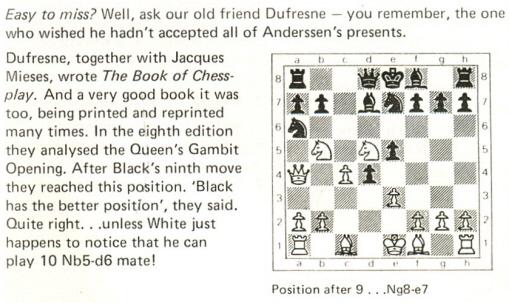
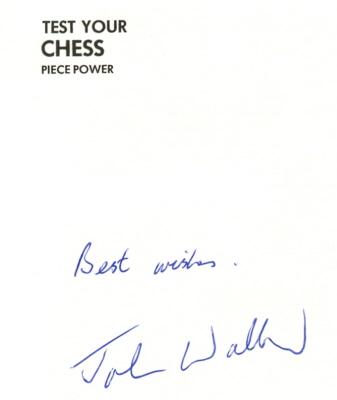
(6544)
Concerning the sixth match-game between Morphy and Harrwitz, Paris, 1858, see C.N.s 6593 and 6634.
A game in which, on consecutive moves, each player overlooked the possibility of being mated on the spot:
Karl Vill – J.B. Meyenborg
New York, 1 January 1902
Ruy López
1 e4 e5 2 Nf3 Nc6 3 Bb5 a6 4 Ba4 Nf6 5 O-O d6 6 d4 Bd7 7 Nc3 Be7 8 Kh1 O-O 9 d5 Nb8 10 Qd3 Bxa4 11 Nxa4 Nbd7 12 c4 Rb8 13 Nc3 b6 14 b4 Qc8 15 Bg5 Re8 16 Nh4 h6 17 Bd2 Nh7 18 Qg3 Bxh4 19 Qxh4 Qd8 20 Qg3 Kh8 21 f4 Rg8 22 f5 f6 23 Qg4 Qe8 24 Rf3 Qf7 25 Rh3 Ndf8 26 Re1 Rc8 27 Ree3 c6 28 a3 cxd5 29 exd5 Qc7 30 Ne4 Qxc4
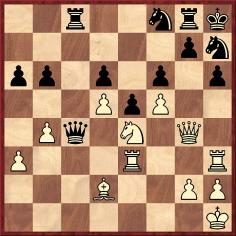
31 Nxd6 Qxg4 32 Nf7 mate.
The game was found by Eduardo Bauzá Mercére (New York, NY, USA) on page 5 of the Brooklyn Daily Eagle, 12 January 1902.
(7785)
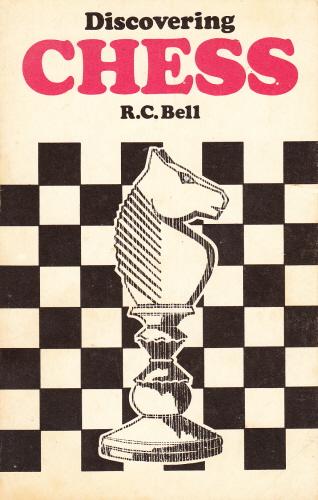
In the original (Aylesbury, 1976) edition of Discovering Chess by R.C. Bell (‘R.C. Bell MB FRCS’) the following is the first of the three diagrams in the ‘End games’ section:
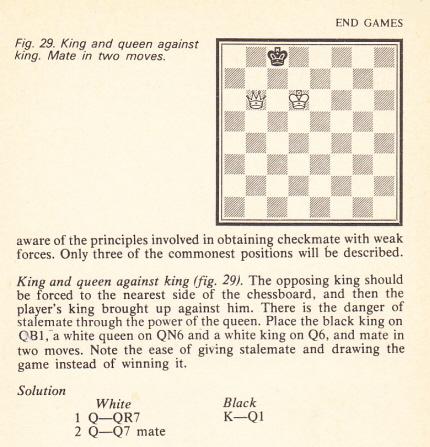
Has there ever been a more elementary ‘analytical error’ in a chess book?
(8460)
From page 19 of the Book of the Folkestone 1933 International Chess Team Tournament (Leeds, 1933), concerning the game Teodor Regedziński (Poland) v Louis Betbeder Matibet (France) in round two, 13 June 1933:
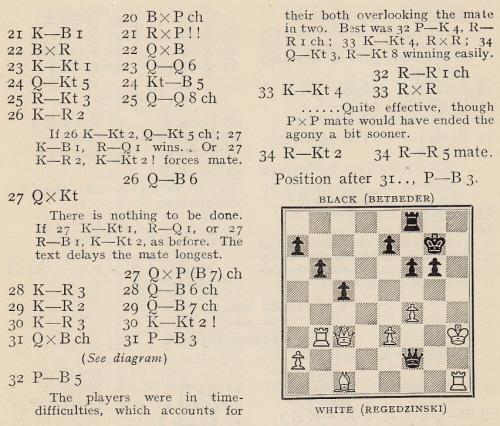
(8758)
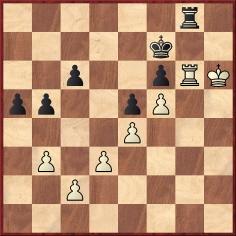
Black to move
Should Black play 39...Rxg6+ and then create a passed pawn on the queen’s side? It has been suggested that this is what Géza Maróczy did in a game against Adolf Zinkl, thereby overlooking a mate in one in the diagrammed position.
From page 366 of CHESS, 14 June 1937:
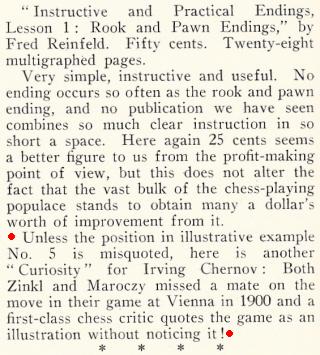
Below is the relevant part of pages 5-6 of Reinfeld’s Instructive and Practical Endings from Master Chess. Lesson I: Rook and Pawn Endings (New York, 1937):
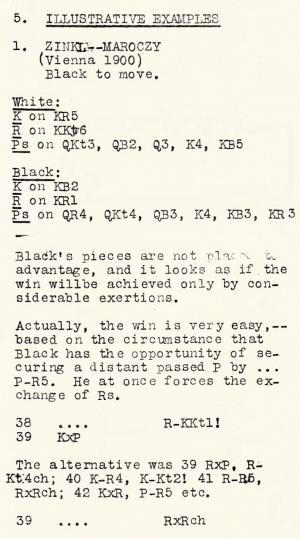

Our copy has an erratum slip:
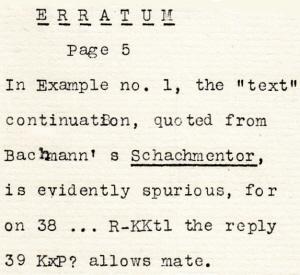
The conclusion of the game was given on page 67 of L. Bachmann’s Schachmentor (Ansbach, 1904):
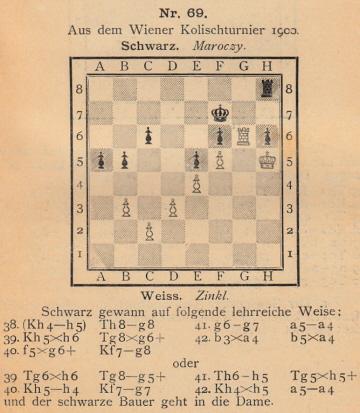
In reality, Zinkl v Maróczy (played in December 1899 in the Second Kolisch Memorial Tournament in Vienna, 1899-1900) ended 38 Kh5 Rg8 39 White resigns. The full game: 1 e4 e5 2 Nf3 Nc6 3 Bc4 Bc5 4 d3 Nf6 5 Be3 Bxe3 6 fxe3 d6 7 Nc3 Na5 8 Bb3 O-O 9 Qe2 Nxb3 10 axb3 c6 11 O-O Ng4 12 h3 Nh6 13 g4 f6 14 Qg2 Nf7 15 Kh2 d5 16 Rg1 g6 17 Raf1 Be6 18 Qf2 Kg7 19 Rg3 h6 20 h4 dxe4 21 Nxe4 Bd5 22 Nfd2 Bxe4 23 Nxe4 Nd6 24 Nxd6 Qxd6 25 e4 Qd4 26 Qf3 Qxb2 27 Rf2 Qd4 28 h5 Qd7 29 hxg6 Qe8 30 Qf5 Qxg6 31 Rg1 Qxf5 32 gxf5+ Kf7 33 Rfg2 Rg8 34 Rg6 Rxg6 35 Rxg6 Rh8 36 Kh3 a5 37 Kh4 b5 38 Kh5
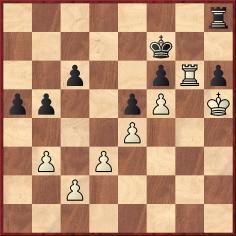
38...Rg8 39 White resigns.
Sources: pages 110-111 of the April 1900 Deutsche Schachzeitung and, as shown below, page 187 of Igy kezdtem ... by G. Maróczy (Budapest, 1942):
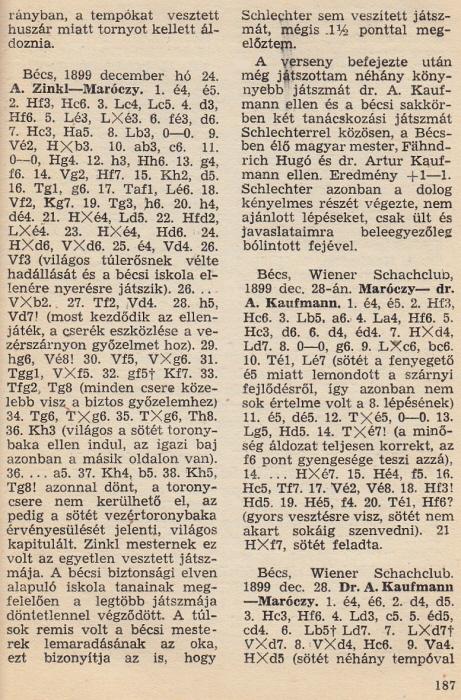
Thus Maróczy committed no oversight. The hypothetical mate in one (39 Kxh6 Rh8) was missed by L. Hoffer when he annotated the game in the 13 January 1900 issue of The Field. After 38...Rg8 he wrote:
‘A very pretty move. If 39 K takes P, then 39...R takes R ch wins ...’
Hoffer’s notes were reproduced on pages 37-38 of Vienna 1899/1900 edited by A.J. Gillam (Nottingham, 2008) without mention of the missed mate in one.
(8858)
The missed mate in one (39 Kxh6 Rh8) can also be found on page 61 of another work by Bachmann which has the identical text:
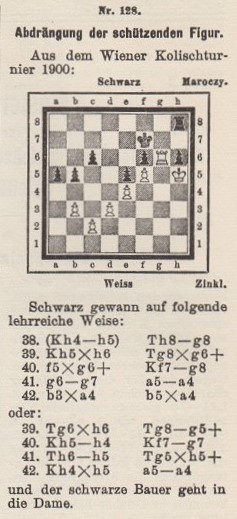
We have that book under two titles, Schach durch Selbstbelehrung u. Selbstunterricht (Berlin, 1929) and Schach Praktisches Lehrbuch (Berlin, undated). The respective title pages specified ‘23. Auflage’ and ‘25. Auflage’.
(8985)
From page 33 of London Feb/Mar 1886 and Nottingham 1886 by A.J. Gillam (Nottingham, 2007):
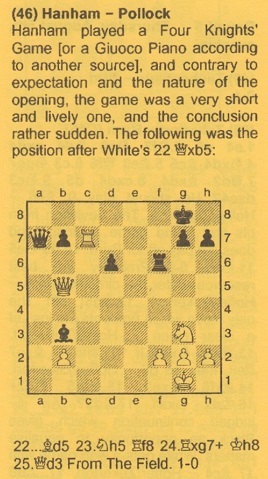
Since ‘The Field’ and ‘another source’ are the sole information offered, and there is no mention of the straightforward mate in four (22...Qxf2+), further details will be appreciated.
(8901)
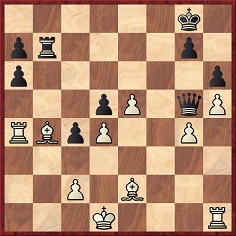
Black to move
In this position from the game between Smyslov and Botvinnik in the 1944 USSR championship in Moscow, Botvinnik played 35...a5, and White resigned at move 41.
In his annotations on pages 16-17 of Chess Review, June-July 1944 Reuben Fine gave 35...a5 an exclamation mark, but on page 2 of the August-September 1944 issue Philip Bromberg of New York pointed out a mate in seven with 35...c3:
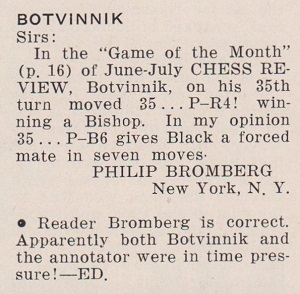
Fine gave due credit to Bromberg on page 109 of Chess Marches On! (New York, 1945), and Bromberg was even acknowledged for the discovery on page 403 of the first ‘Chess Stars’ volume on Botvinnik (Sofia, 2000). Not all writers have shown care, and on page 144 of Mikhail Botvinnik (Jefferson, 2014) Andrew Soltis awarded an exclamation mark to 35...a5.
Earlier monographs such as Partidas selectas de Botwinnik by M. Czerniak (Buenos Aires, 1946) and Botwinnik lehrt Schach by H. Müller (Berlin-Frohnau, 1967) noted the missed mate (see pages 252 and 95 respectively), as did F. Reinfeld on page 209 of Botvinnik the Invincible (Philadelphia, 1946):
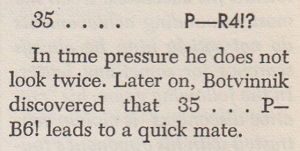
Notwithstanding Reinfeld’s remark, in the two sets of annotations by Botvinnik that we have seen there was no specifically critical comment about 35...a5:

Избранные партии 1926-1946 (Moscow, 1951), page 246

Аналитические и критические работы 1942-1956 (Moscow, 1985), page 54
In the first note Botvinnik stated that 35...c3 was also possible and that there was more than one solution to the problem, and in the second he remarked that there were also other ways to win, such as 35...c3.
From page 3 of the June-July 1944 Chess Review:
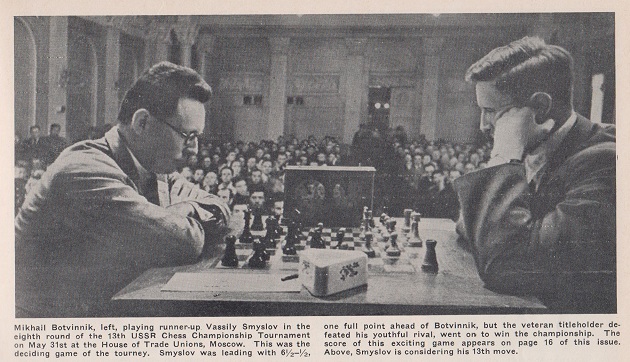
On page 5 Botvinnik contributed an article ‘How I Won The Title’ (‘Via Press Wireless to Chess Review’). After noting Smyslov’s strong start to the tournament, Botvinnik observed:
‘The turning point came in the eighth round when he resigned to me after a stiff battle.’
There was also a paragraph in which Botvinnik described his training for the Soviet championship:
‘For my part, I went to the country with Vyacheslav Ragozin a fortnight before the start. We played quite a few training games with “unknown” results. Our play might have been affected by the radio which was going full blast in the room. We were afraid that the tournament hall might be noisy and decided to accustom ourselves to disturbances. This precautionary measure turned out to be superfluous because the audience behaved well – and Ragozin now insists that the unusual quiet in the hall prevented him from doing better than he did.’
(10371)

White to move
Capablanca played 47 Kh4 and eventually won after 47...Nxe4 48 h6.
The game has been submitted by John Hilbert (Amherst, NY, New York) on the basis of notes which he took many years ago, and we are also grateful to Eduardo Bauzá Mercére for providing the relevant newspaper columns.
Firstly, the score of the game, which was played in a 17-board simultaneous exhibition at the Franklin Chess Club:
José Raúl Capablanca – W.H. Snowden
Philadelphia, 19 November 1915
Bird’s Opening
1 f4 d6 2 e4 Nc6 3 Nf3 e5 4 Bb5 Nf6 5 Nc3 Bg4 6 d3 Be7 7 O-O O-O 8 Bxc6 bxc6 9 h3 Bxf3 10 Qxf3 h6 11 fxe5 dxe5 12 Kh1 Qd7 13 Nd1 Nh7 14 Ne3 f6 15 Nf5 Kh8 16 Qg4 Bd6 17 Nxh6 Qxg4 18 Nxg4 Bc5 19 Be3 Bb6 20 a4 a5 21 Bxb6 cxb6 22 Ne3 Ng5 23 Nc4 Rab8 24 c3 Ne6 25 b4 axb4 26 cxb4 b5 27 axb5 cxb5 28 Ne3 Nd4 29 Nd5 Rf7 30 Ra3 Ne2 31 Rfa1 Rfb7 32 g4 Kh7 33 Kg2 Kg6 34 h4 Kf7 35 Ra7 Nd4 36 Rxb7+ Rxb7 37 g5 Nc2 38 Rf1 Kg6 39 gxf6 gxf6 40 Rxf6+ Kh5 41 Kh3 Ne1 42 Rf5+ Kg6 43 Rxe5 Nxd3 44 Re6+ Kh7 45 h5 Rg7 46 Rb6 Nf2+ 47 Kh4 Nxe4 48 h6 and wins.
Source: the chess column of David A. Mitchell in the Philadelphia Public Ledger, 15 December 1918, page 18:

A report on the exhibition had appeared on page 6 of the Philadelphia Inquirer, 21 November 1915:
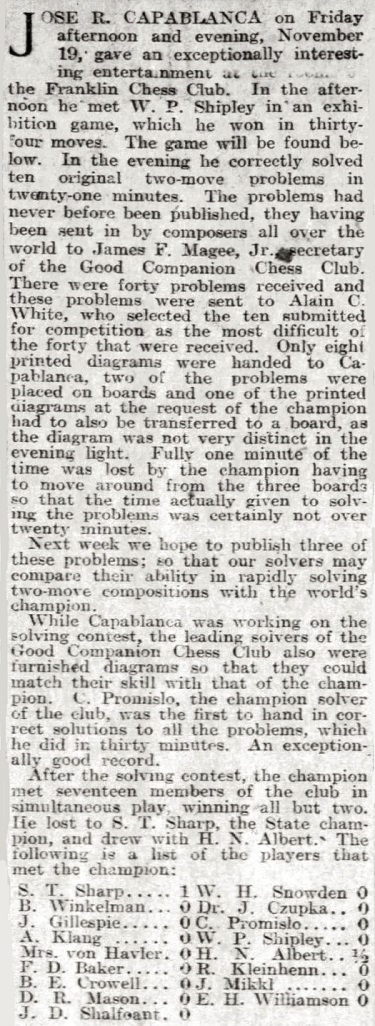
(10851)
David Abrams (Syracuse, NY, USA) points out page 180 of Pandolfini’s Endgame Course by Bruce Pandolfini (New York, 1988):
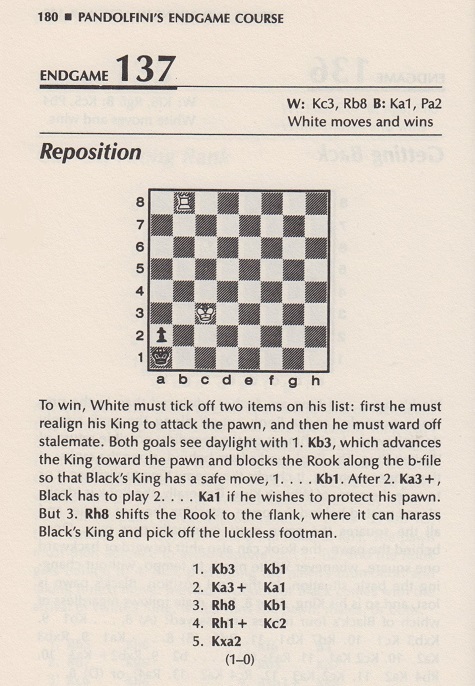
(10516)
Annotators and chroniclers often have difficulty deciding to what extent players who miss faster or easier wins should have such lapses pointed out. To illustrate the theme, we present a range of observations in books by Irving Chernev.
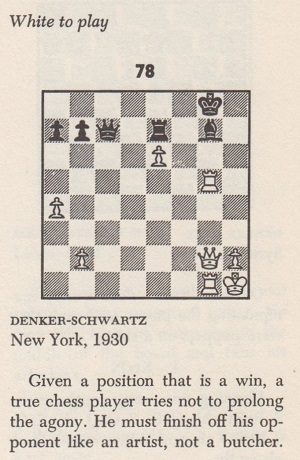
Combinations The Heart of Chess (New York, 1960), page 37
Denker won quickly with 34 Qd5 Kf8 35 Rxg7. The artist/butcher remark is reminiscent of an observation by Emanuel Lasker on page 68 of the Chess Player’s Scrap Book, May 1907 in connection with the game Morphy v the Duke and Count.
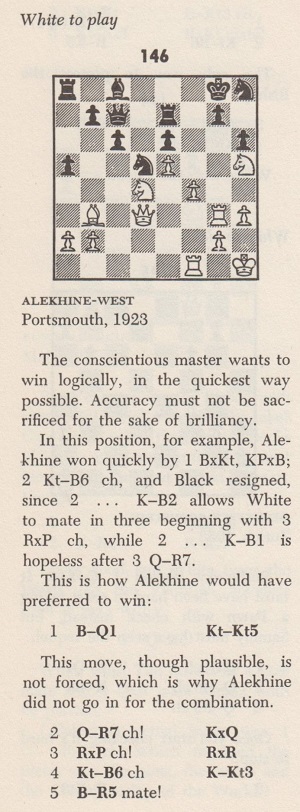
Combinations The Heart of Chess (New York, 1960), page 74
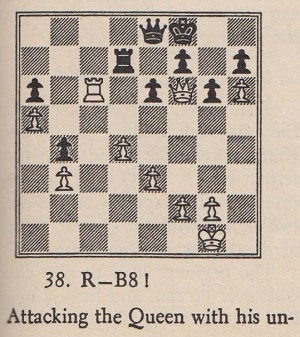
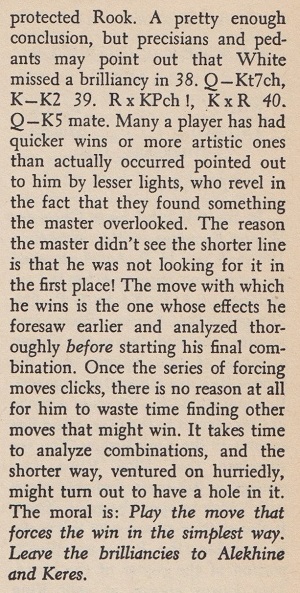
Logical Chess Move by Move, various editions, Game 27 (Chekhover v Rudakovsky, Moscow, 1945)
The almost identical text was on pages 193-194 of The Most Instructive Games of Chess Ever Played (New York, 1965).
Another example is Paulsen v Morphy, New York, 1857:
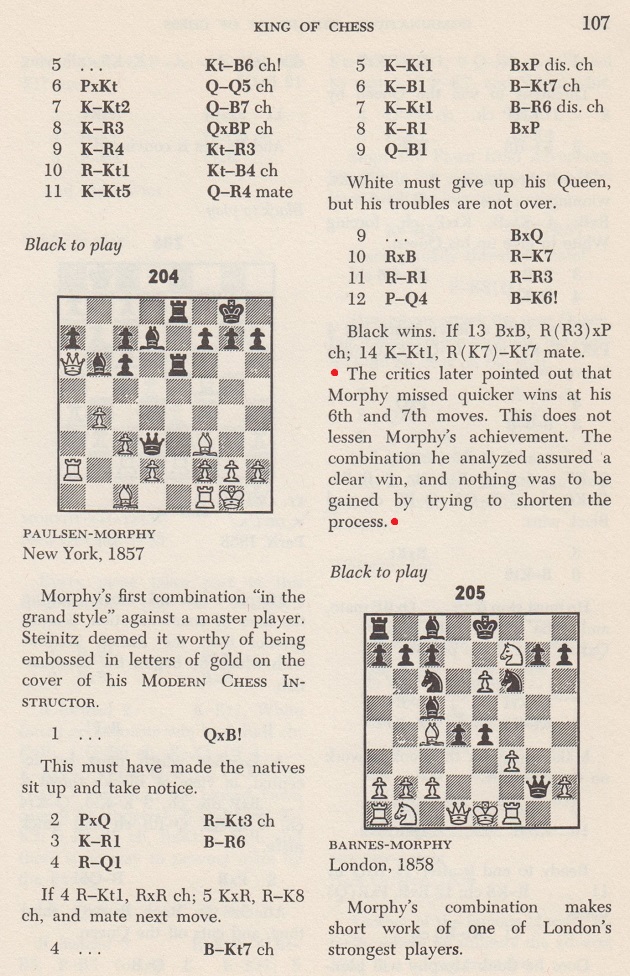
Combinations The Heart of Chess (New York, 1960)
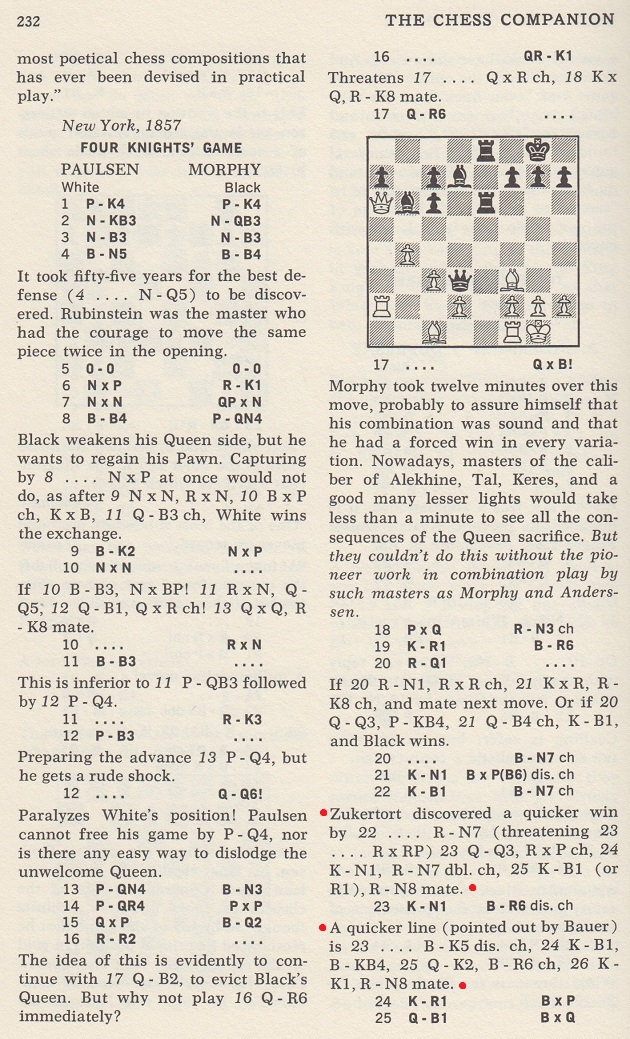
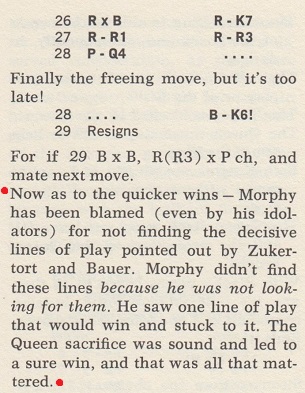
The Chess Companion (New
York, 1968), pages 232-233
The next position comes from a famous brilliancy by Capablanca (White) against Juan Corzo, Havana, 1901:
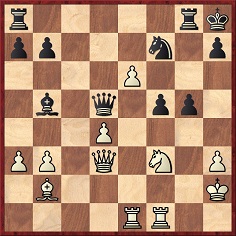
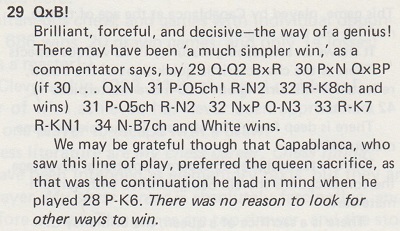
The Golden Dozen (Oxford, 1976), page 284
Virtually the identical text had appeared on pages 175-176 of The Chess Companion.
The ‘commentator’ in question was Fred Reinfeld, in The Immortal Games of Capablanca (New York, 1942). In My Chess Career (London, 1920) Capablanca wrote:
‘Today, very likely, I would simply have played Q-Q2 and won also, but at the time I could not resist the temptation of sacrificing the queen. At any rate, the text move was the only continuation which I had in mind when I played P-K6.’
From later in the same game, where Capablanca played 46 Kf2:
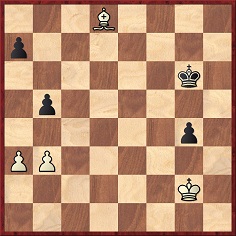
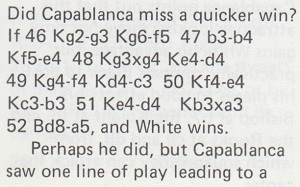

Capablanca’s Best Chess Endings (Oxford, 1978), page 7
Neither Capablanca nor Reinfeld mentioned 46 Kg3. On pages 228-230 of Combinations The Heart of Chess Chernev made no adverse comment on either 29 Qxb5 or 46 Kf2.
A final illustration of the difficulty of avoiding inconsistency comes from page 255 of The Chess Companion, in the conclusion to D. Byrne v Fischer, New York, 1956:
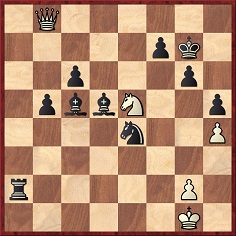
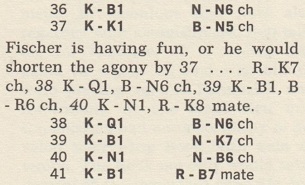
Our feature article on the game shows that the future world champion’s own small book, Bobby Fischer’s Games of Chess, made no reference to the faster mates available at move 36 (...Rf2+) and at move 37 (...Re2+). Those lines would have given mate just one move earlier, and their noteworthiness is a matter of opinion. It is curious, though, that Chernev mentioned only one of the two.
(11105)
Page 18 of CHESS, October 1953 gave Golombek’s win against Fazekas in round ten of the British Championship in Hastings, August 1953: 1 Nf3 Nf6 2 d4 g6 3 c4 Bg7 4 Nc3 O-O 5 e4 d6 6 Be2 Nfd7 7 O-O e5 8 Bg5 f6 9 Be3 Nc6 10 Qd2 g5 11 dxe5 Ndxe5 12 Nxe5 Nxe5 13 f4 Nf7 14 Rad1 h6 15 Qc2 Be6 16 c5 Qe7 17 f5 Bd7 18 Nd5 Qd8 19 b4 Re8 20 Bd4 c6 21 Nc3 dxc5 22 Bxc5 Bf8 23 Qb3 Bxc5+ 24 bxc5 Qc7 25 Bh5 Bc8 26 Rd6 Kg7 27 Rfd1 Re7 28 Bxf7 Rxf7 29 Ne2 Qe7 30 Qf3 Qe5 31 Rd8 Rf8 32 Qh5 Qxc5+ 33 Kh1 Bxf5 34 R1d7+ Kg8 35 Qxh6 Bxd7 36 Rxd7 Rf7 37 Qg6+ Kh8 38 Qxf7 Resigns.
As reported on page 26 of the November 1953 issue, several readers (E.R. Gordon of Stogursey being the first) pointed out that Golombek missed a mate in two towards the end. It was not mentioned whether he was in time-trouble.
(11388)
To the Chess Notes main page.
To the Archives for other feature articles.
Copyright: Edward Winter. All rights reserved.